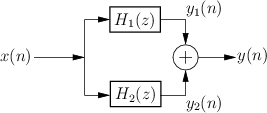Series and Parallel Transfer Functions
The transfer function conveniently captures the algebraic structure of a filtering operation with respect to series or parallel combination. Specifically, we have the following cases:
- Transfer functions of filters in series multiply together.
- Transfer functions of filters in parallel sum together.
Series Case
Figure 6.1 illustrates the series connection of two
filters
![]() and
and
![]() .
The output
.
The output ![]() from filter 1 is used as the input to filter 2.
Therefore, the overall transfer function is
from filter 1 is used as the input to filter 2.
Therefore, the overall transfer function is

Parallel Case
Figure 6.2 illustrates the parallel combination of two
filters. The filters ![]() and
and ![]() are driven by the
same input signal
are driven by the
same input signal ![]() , and their respective outputs
, and their respective outputs ![]() and
and ![]() are summed. The transfer function of the parallel
combination is therefore
are summed. The transfer function of the parallel
combination is therefore

Series Combination is Commutative
Since multiplication of complex numbers is commutative, we have
By the convolution theorem for z transforms, commutativity of a product of transfer functions implies that convolution is commutative:
Next Section:
Partial Fraction Expansion
Previous Section:
Factored Form




















